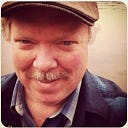Find the Writer Inside the Copywriter
“Copywriter” is a dense word in need of deconstruction. The person who hears this word must know what “copy” is, or the phrase falls flat. That’s a real problem for thousands of professional writers who struggle to communicate their value, outside and inside the confines of the creative department.
“Copy” is a word from journalism that was adopted by early advertising practitioners. A copywriter was the person who produced the word outputs, a.k.a. the advertising copy, that was then handed over to the art department for layout.
Is this how things work today? Does the term “copywriter” hold water now?
Since the dawn of the Creative Revolution in the 1960s, copywriters and art directors have moved closer together. Their shared responsibility is to come up with ideas, also known as “concepts.” The writing comes later, sometimes much later, because writing ads is finish work. Figuring out what to write and how to write it is the real work, and making communications that matter requires training, skill, and lots of practice.
There are lots of different kinds of copywriters. Some write direct mail copy, for instance, and others who write white papers, and still others who entertain people on social media. Some copywriters who focus on brand building, and others who focus on conversions. It’s critical for clients to know the difference and to know which kind of writer they’re hiring.
To know even more about the writer in question, next time you interview a copywriter, ask this question: Can you describe how your favorite writers from outside of advertising have an impact on your work in advertising?
In Today’s Always-On Omnichannel Mediaverse, You Need Exceptional Stories (Or No One’s Going to Hear You)
For practicing writers there is the literary market, the entertainment market, the journalism market, and the advertising market. When you work in advertising, all of the sister industries are part of the big picture.
When you go to bat for a brand, you will rely on the same narrative structures that novelists use, you will write dialogue like a screenwriter, and you will tell long-form brand-sponsored stories in print and broadcast, like a journalist, and you will condense much meaning into three-to-six word phrases, like a poet.
In the video above, I describe how I am a hybrid, journalist-poet who works as an ad maker. To take this a bit further, I like to enter the room with a beginner’s mind, ask a series of “dumb” questions, take notes, compile notes, get a feel for the audience and how to solve the communications problem(s). With this as a starting place, a communications strategy can be drafted.
A strong strategy will lead the creative team to generate lots of ideas, some more creative (and therefore appealing) than the rest. When the winning idea is found and shared, the crafting begins. To give the winning idea shape and bring it to life, the writer will rely on technique. The narrative arc will come into play, the plot will be developed, the tone of voice perfected.
My favorite writers inform me, and thus they impact my work. We learn from the masters and we do the best we can to weave their lessons into our own work and life. My favorite writer of all time, Kurt Vonnegut, was a humanist who used satire to expose human fragility.
“Laughter and tears are both responses to frustration and exhaustion. I myself prefer to laugh, since there is less cleaning up to do afterward.” -Kurt Vonnegut
Copywriters — the writers who shape and convey corporate messages in artful ways — are hired to make sponsored messages appealing, noteworthy, and actionable. It’s a tall task.
I lay all this out because there are thousands of business owners and marketers who need the expert help of people who write ad copy. But they don’t know where to find these experts, or how to approach them, or how to work with them, and so on. The writer is a mysterious beast and such creatures are not always welcome in corporate confines.
This is why we seek to keep the jester in the room, something that another favorite writer of mine liked to do. Ken Kesey and Kurt Vonnegut were as serious as men can be, but they also insisted on having fun, not taking everything so seriously, and they worked hard to foster joy in others.
The best copywriters remember the base needs of every person in every audience — to be recognized, respected, and loved. You can’t get anyone’s attention or move them to care or believe or buy just by presenting a client’s offers. The offers announce themselves. The “why should anyone care ?” part…that’s another matter entirely. When you need people to care, and want them to understand things on an emotional level, which creates belief and action, a good writer is a good ally to have.
Do you want to talk to me about copy, the art of brand storytelling, and how to get the most from the copywriters you work with? I’d love to hear from you. Find me at http://davidburn.com.
